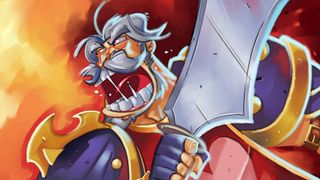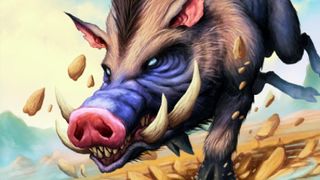Hearthstone's veterans are weirdly excited about getting smacked by Leeroy all over again
The OG pros and streamers can't wait for the launch of Hearthstone Classic, but how long will the nostalgia last?

Back in the particularly dense mists of time, Leeroy Jenkins somehow cost 4 Mana. On turn eight, Warlock players would build a Molten Giant wall, and make you pay for it. Mage mains could enjoy two turns of immunity thanks to Ice Block, before unleashing a rage quit-inducing wombo combo of spells. Oh, and the average Rogue pop off concluded with half the deck drawn and a 20-attack Edwin VanCleef hiding in a cloud of smoke.
The time of which we speak is, of course, vintage Hearthstone. The arrival of the Classic mode later this year will transport us to the dawn of the game, long before a series of balance changes and expansions sanded the power off the Basic and Classic sets. For almost a year, between the game's beta in 2013 and official release in 2014, Blizzard's ludicrously popular CCG consisted of exactly 240 cards. Before we got used to regular expansions, Hearthstone was essentially a closed loop. For those of us who still play, this was the era we first fell in love. It was a million Handlock vs. Control Warrior games, playing out for eternity, which is exactly what that match-up often felt like.
The clock will be wound back to March 11, 2014, enabling us to Shadowstep Leeroy like it's the middle of the Obama era.
Soon, we'll have a chance to relive those salad days, exactly as they were. A raft of seismic changes are coming to Hearthstone in 2021—the forthcoming core set will fundamentally change the game's pricing structure, while the new Mercenaries mode will hope to mirror the success of Battlegrounds—but, for many OG players, the unveiling of the Classic format is actually more exciting. When it launches, the clock will be wound back to March 11, 2014, enabling us to Shadowstep Leeroy like it's the middle of the Obama era. Everything we used to rage about—not least the manifold Alt-F4's after a smug Druid dropped the Force of Nature/Savage Roar combo—can now be experienced again, this time as winsome memory. It might only have been seven years, but the nostalgia is real.
"I honestly miss the thrill of competing with my peers," says Andrew "Kitkatz" Deschanel, a former Hearthstone streamer and pro, who was active in the earliest, most chaotic era of Hearthstone esports. Kitkatz was a Warrior main who became Hearthstone famous for inventing the meme that Armorsmith always wins Brawls. (Somehow his ones did seem to, whereas for the rest of us the mileage very much varied.) "The announcement has me thinking about a return for a fun tournament with other class experts."
Naturally, once Classic goes live, Kitkatz is looking forward to once again armoring up a billion times before emoting "Heh, Greetings" as Cruel Taskmaster sends an enraged Grommash Hellscream to an opponent's dome.
Are you telling me you built a time machine...
Though he joined the scene a little after launch, the indomitable Brian Kibler also plans on dipping his toes into Classic. He remembers his first journey to Legend came by piloting a rickety, no-legendary midrange Shaman deck. "Maybe I'll see if I can do it again," he says.
Personally, I'm most excited about returning to Miracle Rogue, back when that decklist was at its most obscenely overtuned. To think that a generation of Hearthstone addicts never experienced the horror of a stealthed 5-Mana Gadgetzan Auctioneer! For some modern players, raised on the infinite value generation of Lackeys, and a distinct lack of Charge minions, it's going to be quite the rude awakening.
The biggest gaming news, reviews and hardware deals
Keep up to date with the most important stories and the best deals, as picked by the PC Gamer team.
None of the veterans I spoke to felt confident about how sturdy the Classic player base will be long term. Surely, grognards like me are going to jump in at launch and mess around with a few ancient lists resuscitated from the abyssal depths of Hearthpwn. Plenty of Hearthstone's more recent adopters may also enjoy the history lesson. But will there still be a reliable community in 2022? Kibler doubts it. "What I like about CCGs is that they change and evolve and present new challenges, which a classic format obviously isn't going to do," he says. "It may have some die-hards who stick with it, though."
He's right of course, as Kibler usually is. I don't think there is going to be a robust competitive element to Classic, though it will have its own ladder, and the lack of changes will surely see the population drift. But I do hope that enough people will be playing indefinitely so that I can jam a little vintage Handlock whenever that particular itch requires scratching.
Above: The six-minute documentary which introduced the game back in 2014. May contain Bloodfen Raptor.
The bigger question, I think, is why a game that's relatively young (in Blizzard terms, at least) is capable of generating so much nostalgia, to the point that an announcement like this feels liberating for certain people. Kitkatz points to the success of World of Warcraft: Classic, which is gearing up for its first expansion with The Burning Crusade. But World of Warcraft is more than 15 years old, and was accompanied by a steady rollout which ensured that the world never felt stale for long. Grown tired of Molten Core? Don't worry, Blackwing Lair is right around the corner.
Hearthstone Classic isn't nearly as old, and it has no carrot-on-a-stick to keep players going. Well… I suppose there is an outside chance that Blizzard eventually announces some sort of rolling time loop where Classic integrates the Curse of Naxxramas meta or whatever. But I wouldn't get my hopes up.
A fresh cadre of Twitch personalities like Reynad, Kripparrian, and Amaz materialized, fully formed, seemingly out of nowhere.
Instead, Kitkatz correctly points to the culture that surrounded 2014-era Hearthstone as the inflection point for his own sentimentality. What a time it was! There were late-night tournaments every weekend with bloated prize pools and marathon broadcasts. A fresh new cadre of famous Twitch personalities like Reynad, Kripparrian, and Amaz materialized seemingly out of nowhere, and took center stage in the notoriously fickle streaming industry. Esports organizations were signing CCG maestros like they were League of Legends phenoms. Briefly, everything felt possible. Hearthstone remains a popular videogame, but that kind of zeitgeist is gone and unlikely to truly come back, however dynamic the dev team becomes.

For more info on the iconic cards which are not going to be sticking around in Standard when the Core set arrives, check out our article detailing the classes likely to be hit hardest.
"The early years of Hearthstone meant so much to me," says Kitkatz. "You saw streamers coming from myriad gaming backgrounds, or even just card universes, to find love and enjoyment in the same place. That diversity brought so many different ideas about the right or optimal way to play the game and brought so many spirited debates." .
Specifically, Kitkatz mentions Rumay "Hafu" Wang, a World of Warcraft arena player, who migrated over to Hearthstone without missing a beat. The whole multiverse of Blizzard fans briefly took roost in this card game. Some of them stayed, but most have since moved on. When you take stock of the scene now compared to what it once was in its early days, I understand if some feel like the vibe is off now.
Obviously, you can't go back. Not really. This is what happens when a game enters its middle years. Look at how the fortunes of Overwatch and PUBG have waxed and waned. Hell, even Fortnite isn't quite the same heavyweight as it was in 2017. Whether you're eager to push the game to its limits with a bevy or new cards or if you truly believe that the meta was perfectly balanced with a 2-Mana Starving Buzzard, Hearthstone now has your back. The game contains multitudes, now more than ever.

Luke Winkie is a freelance journalist and contributor to many publications, including PC Gamer, The New York Times, Gawker, Slate, and Mel Magazine. In between bouts of writing about Hearthstone, World of Warcraft and Twitch culture here on PC Gamer, Luke also publishes the newsletter On Posting. As a self-described "chronic poster," Luke has "spent hours deep-scrolling through surreptitious Likes tabs to uncover the root of intra-publication beef and broken down quote-tweet animosity like it’s Super Bowl tape." When he graduated from journalism school, he had no idea how bad it was going to get.
Most Popular


